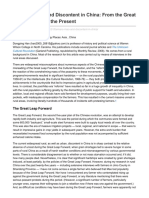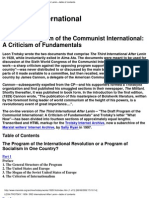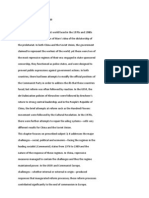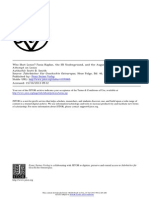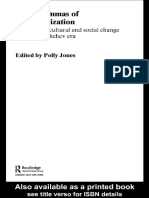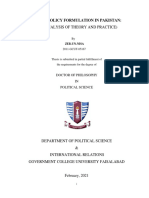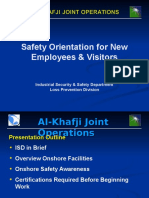Mao's Changes
Mao's Changes
Uploaded by
sh805657Copyright:
Available Formats
Mao's Changes
Mao's Changes
Uploaded by
sh805657Copyright
Available Formats
Share this document
Did you find this document useful?
Is this content inappropriate?
Copyright:
Available Formats
Mao's Changes
Mao's Changes
Uploaded by
sh805657Copyright:
Available Formats
Primary Sources:
"A Cultural History of Late 20th Century China." A Cultural History of Late 20th Century China. N.p., n.d. Web. 07 Oct. 2013. This shows the analyzed part of a political picture that was posted all around china. It show that no matter where you are at the phrase mob mentality still applies. The people of China does whatever the person next to him is doing. Every single person was involved in the cultural revolution due to the mob mentality, which was significant in the influence of the Communist party- this was displayed in a propaganda poster that we used.
"China Notes: Superfluous Musings of a Chinese Historian." Is Cantonese in Danger of Extinction? The Politics and Culture of Language Policy in China. N.p., n.d. Web. 16 Nov. 2013. This article talk about how Mao presented his proposal to change the culture of ancient China. We used the poster that had the four olds crossed out. This shows that Mao wanted to get rid of old culture like architecture, artifacts, and meaningful sculptures. This provided in depth information into our understanding of the "Great Cultural shift" of China, especially, the changes in the language as time progressed (presented on the "Passive Resistance" page). Chinese Nationalists, The East Is Red. PRC, 1964. MP3. This composition was made on account of reflecting the culture of the Chinese nationalists and their perspective (leftist) towards the government. This provided a valuable source of culture that was unique as an extension to the expression of the people themselves provided within the "rights" section. Chinese Revolution. Digital image. Chinese Revolution. N.p., n.d. Web. 16 Oct. 2013. A young group of kids called the Red Guard gathering during the revolution. The little youngsters were in support of Maos communist ways. This show that it doesnt matter the size or age, communism will affect you. The valuable understanding of the events are presented through our use of the source's media to express these ideas and specifically representing the Red Guard in an image. This identified the particular characteristics for our information and a visual reference of the time period.
"Class 4: Health Campaigns of the Masses, 1950s-1970s." U.S National Library of Medicine. U.S. National Library of Medicine, 15 Mar. 2012. Web. 09 Jan. 2014. Many posters were hanged around the countryside of china and they were filled with valid information. During the Cultural Revolution many posters were posted about the 'barefoot doctors' and the help that they were going to provide for the people of china. The barefoot doctors were a valuable sources of help to many people of China because they cured many diseases and minor ailments, which provided a differentiated understanding of the opinion to the culture of Communist China. This source provided some cultural information that was recorded upon the "passive resistance" page. "Cultural Revolution Overview - China 1972 Image Database." Cultural Revolution Overview - China 1972 Image Database. N.p., n.d. Web. 07 Oct. 2013 This valuable piece of information states that the year that the The Great Proletarian Revolution was no walk in the park. This event is also known as the decades of chaos. Many officials and intellectuals were persecuted during this time. This revolution effected everyone not only the commoners. This piece of information was used to understand how the officials and commoners were persecuted; this information was presented through the "Small Leap Forward" page.
"Discovering China: The Cultural Revolution." ThinkQuest. Oracle Foundation, n.d. Web. 19 Nov. 2013. This piece of information was used to give a brief description of the negative effects that Mao had on China. The negatives are the decline of food and cotton production throughout the land of china. Also, the website gave a description on how the group of jiang affected the flow of production.
Dzimas. The Red Peril. American Historical Perspectives. Blogspot.com. 26 Dec. 2012. Web. 07 Nov. 2013. An image of Stalin and Mao presented together along with citizens raising their national flags, which identifies the shift of Chinese policies to those similar of Russia. The political poster also emphasizes the both leaders positions by their location in the image and direction of their gazes. This was used as an useful source to identify the spread of the Communist practice, which was used as a actual image for display.
Eckstein, Alexander. China's Economic Revolution. Cambridge: Cambridge UP, 1977. Print. In the book, Mr. Eckstein tells how the economy of China has greatly decreased throughout the year. In the years before Mao, Chinas economy was flourishing to the Country it had to be. We used this information to compare the economy of China before Mao and and after Mao.
Emelianov, Mikhail. Cultural Revolution Posters (1966-67). Perverse Egalitarianism Blog. WordPress Blogs. 04 Nov. 2013. Web. 05 Nov. 2013. This website provided a particular images that was a political cartoon of a character being criticized for his view and the need for public appeal against the citizen. This provided us of an example of a form of public criticism towards a particular political character.
"FEATURES." Focus. N.p., n.d. Web. 20 Nov. 2013. In this article it talked about how the cultural revolution increase the production of tea. The article offered a line chart that we were able to use on the web site. We used the statistics that the paragraphed had and quote some of it into the website. During this time period only production of tea was successful.
"Four Olds-Brian - Red Scarf Girl - Group B." Four Olds-Brian - Red Scarf Girl - Group B. N.p., n.d. Web. 18 Nov. 2013. The information was used to find what cultural destruction and the Red Guard caused on China. The red guard destroyed many priceless artifacts and many architectural structures. We wrote all of the information gathered into a small paragraph and describe how it affected china.
Funkhouser, Giuliana, and Joyce Hsu. "Timeline of the Great Proletarian Cultural Revolution."Http://academics.wellesley.edu/. Professor William A. Joseph, 8 Aug. 2003. Web. 19 Nov. 2013. This website was used in order to find more information the timeline of the Cultural revolution. It provides another version of the timeline and the events that occurred during it with different parameters. It provides specific dates to the transition of the governance from the original traditional government to the Communist party, and the transition of Mao's strict Communist economic system to the economic reform of Deng's rule.
"Great Proletarian Cultural Revolution." Joyces Blog RSS. N.p., n.d. Web. 07 Oct. 2013. The cultural revolution started from 1966 to 1976. This revolution started when Mao Zedong wanted to remove capitalism, tradition, and cultural elements. He also wanted to introduce Maoist orthodoxy into the party. This revolution gave power back to Mao after the failed attempt of the Great Leap Forward. This provided us with more general information about the topic for initial research.
Harms, William. "China's Great Leap Forward." China's Great Leap Forward. The University of Chicago, 14 Mar. 1996. Web. 19 Sept. 2013. This was a report from the University of Chicago that had more exclusive information on the happenings of the Great Leap Forward. It has an interview with Dali Yang, whose parents were in the Great Leap Forward, explained from his parents account- who was affected. The report provided some of the first primary sources that we used to reference the influence of Mao and understand our topic. Heisey, Rey. Chinese Perspectives in Rhetoric and Communication. Stamford: Ablex Publishing Corporation, 2000. Print. This source provided us with valuable information of peoples personal experiences, which allowed us to understand the nature of the difficulties that the people had to subjugate. The source reflects upon various forms of literature composed by Mao that represent his own emotions during the time of his rule, which allowed to validate some of our other information to make sure that they are reliable. 'Historic Lesson of Chia's Cultural Revolution, Cultural Revolution Unfolded." Historic Lessons of China's Cultural Revolution, Cultural Revolution Unfolded. N.p.,n.d. Web 06 Jan. 2014. In the detailed 'Description of Anti-Revisionism On-line' it describes how the cultural revolution was a great impact on the health on the people of China. The article describes how the Cultural Revolution helped to improve the health of many citizens of China. This valid information was used in the section 'The mental and physical effect of the people of China' under the "Passive Resistance" tab to provide a reference to the health condition of the citizens.
"HRIC Human Rights in China." The End of Innocence. HRIC, n.d. Web. 20 Nov. 2013. This was a useful website that gave a detailed description of how Mao Zedong was back in power and how he planned to start a cultural revolution in China. This was apart of the sources that we used to specify our topic and gain greater depth into the subject. "Hua Guofeng." Theguardian.com. Guardian News, 20 Aug. 2008. Web. 19 Nov. 2013. This website assisted me with giving me more information on Hao Guofeng. It tells that not only was he successful in becoming vice primier, but also that he took Mao's place and became chairman. This provided us with an additional character to add to the timeline.
Hua Guofeng. 1977. Photograph. Chineseposters.net. Chinese Postetre. Web. 13 Nov. 2013. This image is of Hua Guofeng, the premier that took position after the death of Premier Zhou Enlai. This picture is used in the timeline as reference to know who he is.
Landsberger, Stefan R. Great Leap Forward (1958-1961). Chinese Posters.net Chinese Posters Foundation. 5 July. 2013. Web. 1 Oct. 2013. This resource provided us with some visual representations of the political emphasis placed on romanticizing the benefits of industrializing the country. The ideology represented was to represent the superiority of the working class to compare it to that of the West. Liu Shaoqi. N.d. Photograph. Http://p2.img.cctvpic.com/. Web. 16 Nov. 2013. This image is of Liu Shaoqi, who at ruled over China at one point as president, though he was revoked and later killed. Liu Shaoqi was one of the revisionist that were known to the public due to his actions and disregard of the poor. This image was used in the timeline. Long Bow Group, inc. "Ask Chairman Mao for the Answers to your Problems; A Personnel File". Long Bow Group Productions. Web. Jan 10. 2014. Within this website, there were two specific pages that contained some first-hand accounts of events. The documents were of original origin- specifying the method of the party to improve their approach to party rule and a list of individuals that were exiled and their confiscated belongings. This source provided us with a reflection of the conditions that the citizens of China were placed in, so we used the first article as an interactive source to display.
Liu Shaoqi, Deng Xiaoping and Tao Zhu Must Get out of the Central Committee of the Party! 1967. Photograph. Http://chineseposters.net. Http://chineseposters.net, 24 Dec. 2013. Web. 9 Feb. 2014. This is a poster of how the CCP felt about the anti-rightists in the party, which were, to name a few, Deng, Liu, and Tao. All of these men were removed from the party for a limited time, or for good. This image was implemented into the timeline as a visual aid to what the people thought about the CCP's party members. Lu, Xing. Rhetoric of the Chinese Cultural Revolution: The Impact on Chinese Thought, Culture, and Communication. Columbia, SC: University of South Carolina, 2004. Print. Xing Lu describe her life during the cultural revolution. The information that we used spoke about how her mother and father were suffering due to the persecution by the Red Guard had caused. The red guard was to blame for the damage that was caused to people physically and mentally. Many people of China were psychologically due to the Red Guards destructive ways. There ways influenced many people to rebel against the government and their co-workers. This was used as quoted information for the "passive resistance" page.
Poon, Leon. The Peoples Republic of China: The Great Leap Forward (1958-1960). University of Maryland. Web. 1 Oct. 2013. Industrializing the agricultural sector proved to be a challenge to impose. The rapid approach did not consider the human factor of the position and led to deterioration in the social structure in particular family, which was reduced to the mass-gatherings and components of communal-living. This information was expressed in the summary of the "Small Leap Forward" section to reference the conditions that the citizens were experiencing during the time period. Peking Review, "Decision of the Central Committee of the Chinese Communist Party Concerning the Great Proletarian Cultural Revolution". Peking Review. Volume 9, #33. Aug 12. 1966: 6-11. Print. This valuable source provided a background into the various approaches that the Communist Party used to maintain control of the masses. This information included in the source was used for quotes from specific reformists, and it identified the "responsibility" of the government to maintain stringent regulation. Red Guard vs. Religion. 1967. Photograph. Wordpress.com. Wordpress.com, 16 Apr. 2012. Web. 9 Feb. 2014. This is an image of a worker of the red guard destroying the symbols of religion during the time of the Cultural Revolution. These were destroyed at the time due in order for the public to focus on Mao Zedong and their work for the cultural revolution. This limited the rights of the people. This was implemented in the timeline for a visual aid to the early years of the Revolution. Schaefer, Torre, Lisa, and Kerry. China's Great Proletarian Cultural Revolution. Hofstra University. Web. 15 Oct. 2013. PDF document. The information includes a general overview of the effects that resulted from the Maos incontrovertible policies and it included some examples of how citizens were influenced by his policies. We will use this as a future source to determine the outlook of Mao's policies many decades following the revolution. Serve the people. Digital image. : The Battle for Chinas Present: Mao and the Cultural Revolution. N.p., n.d. Web. 17 Oct. 2013 In this website the picture of the red guards destroying books, furniture, and other valuables because it symbolised the destruction of the past. It meant smashing the four olds (old ideas, old culture, old habits, old customs). The presentation of some of the cultural changes that occurred throughout the time period, which was reflected in the "passive resistance" page.
Simkin, John. "Zhou Enlai." Spartacus.schoolnet.co.uk. Spartacus Educational, n.d. Web. 19 Nov. 2013. This website provided information on the life of Zhou Enlai, the primier and foreign of the Republic of China from 1954-1976. Zhou was also a supporter in the Red Guard, who were formed to remove the CCP's Gang of Four and the changes they made. This website was used as a reference point to provide information to the timeline.
Stamp of Approval. 1968. Photograph. Wsj.com. Dow Jones & Company, 20 Oct. 2011. Web. 9 Feb. 2014. This image is a photo of a stamp used as approval from China. This stamp is selected to symbolize the approval of the CCP for the Cultural Revolution. We used this in the timeline to display such. "The Great Leap Forward." Http://www.historylearningsite.co.uk/. History Learning Site, n.d. Web. 03 Oct. 2013. This we website was used by us to retain an overview of what the great leap forward was about. It briefly explains Maos focus, the impact, and his motivation in every aspect of the 2nd Five Year Plan. It explains the positive effects as well as the consequences of his plan, such as rationing and faulty factories. A historical reference to the "Great Leap Forward" was presented in the "Small Leap Forward" page, which used the information to summarize the vast content to the reader. "Web Page Template." Web Page Template. N.p., n.d. Web. 07 Oct. 2013. This article show the negative view of The Great Proletarian Cultural Revolution of China. Some of the effects were that Industrial and Agricultural declined greatly. Also the change in school change the amount of manpower that China received in the later years. This information was identified within the "small leap forward" page as an additional reference. "Web Page Template." Web Page Template. N.p., n.d. Web. 19 Nov. 2013. This web template was very useful to find information needed for the Red Guard. We were able to use this information on the section of the section where we were talking about the impact on Chinas Culture. The web site gave a specific number of documents and buildings that were destroyed during this time period. We will also be using the information provided in this web site in a later period. to represent the progression of Mao's rule through the early years into the concluding years of the dictatorship.
Wei, Jingsheng, "Democracy or a New Dictatorship?" Wild Lily, Prarire Fire: China's Road to Democracy, Yun'an to Tian'anmen. Princeton: Princeton University Press. 1995. Print. The physical evidence presented within the documents provide emphasis towards the conscience of the people, and with the author being a political prisoner- his perspective provides a definition of the responsibility of society and that's where the purpose provided within the quote was used. Xi'an ANZ International Travel Service Co. The First Communist Party Congress. China National Tourism Administration. Web. 07 Nov. 2013. The image that was found within the database was of an important historical landmark in the history of Communist China. This image was used as a representation of Chinas preserves for historical areas on the "revolution of ranks" page, and an actual heritage site that relates back to that time period.
Secondary Sources:
"A Hero of the Revolution Falls Hard." CNN.com. Cable News Network, n.d. Web. 18 Nov. 2013. This website explains background information on Lin Biao. Lin Biao was a Communist General for China with a great battle history and a strange death. This was used as a resource to learn about exactly how Lin Biao expired and was incorporated into the timeline.
Akbar, Arifa. "Mao's Great Leap Forward 'killed 45 Million in Four Years'" http://www.independent.co.uk/. Independent Digital News and Media, 17 Sept. 2010. Web. 03 Oct. 2013. This is a news report on the negative after effects of the Mao's Great Leap Forward, which caused 45 million lives due to starvation and beatings. It shows in detail what caused the deaths of so many, labeling Mao Zedong as a mass murderer. The presentation of these statistics contributed to the understanding of the social stage of China- through the forceful changes that the Communist party instituted among the citizens- on the "Small Leap Forward" page. When we were developing our "small leap forward" page, we used this resource as a reference to the horrid affects of Maoist policies.
International Communist Conspiracy. The Mythology of the Great Proletarian Cultural Revolution and the Chinese Ultra-left. WordPress Blogs. 22 Aug. 2013. Web. 25 Oct. 2013. This source referenced a double-perspective of the leftist and the rightist parties and compared their particular stances upon the issues. It was used for the purpose of identifying how the transition in China took place through Socio-political events. The separation of these parties was presented within the "revolution of ranks" page by identifying the political environment that the leaders in high government positions were categorized in. Lieberthal, Kenneth G. "Cultural Revolution (Chinese Political Movement)." Encyclopedia Britannica Online. Encyclopedia Britannica, n.d. Web. 07 Oct. 2013. This source was useful due to the decent photos and provided good information relating to our topic. It focuses on Mao Zedong's leadership and the suffering he experienced. The cultural expanse of the Mao's policies allowed us to develop the particular role of Mao and the relation to the depravation of resources of the people.
MacFarquhar, Roderick. Perspectives on China: Timeline of Events. Harvard History Department, Harvard University Press. Web. 10/21/13 The events that were presented within the time period were relevant to summarizing the information that was needed to include specific dates. This source included information about the period before the revolution and after to give us an overlook of the revolutions purpose in history.
"Reformer with an Iron Fist." CNN. Cable News Network, n.d. Web. 17 Nov. 2013. This news page gives me a full overview of Deng Xiaoping and his life as a vice-primer, before and after his time. It shows his rise to power from general secretary for communism to vice-premier. We used this as a source to show how he rose to a higher form of power over time.
Saich, Thomas, Yang, Benjamin. The Rise to Power of the Chinese Communist Party. Armonk: M. E. Sharpe, 1996. Print. The information that this book covered included the details of the historical/ political components of the Chinese government and it presented us with the specific views of the governing bodies. This resource allowed us to specify our topic from the broad category of Communism in China to the proletarian revolution in the country.
Szczepanski, Kallie. "What Was the Cultural Revolution?" About.com Asian History. About.com, n.d. Web. 18 Nov. 2013. This website provided good information concerning how the citizens of China were treated during the Cultural Revolution. Most of the given info contributed to the fact that the people were treated harshly. This was a general reference to the actual topic, which was used specifically for the "passive resistance" page. "The Cultural Revolution (Timeline) - Asia News." Asianews.it. AsiaNews, 16 May 2006. Web. 18 Nov. 2013. This page was the main source of reference for the timeline. It provides information of what happened during the Cultural Revolution and after that. It provided me with lots of information with an addition of Chinese history more relevant to today. This was used for understanding the general order of the events that took place from 1966-1972 (recorded on the timeline).
"The Great Proletarian Cultural Revolution in China, 1966-1976." The Great Proletarian Cultural Revolution in China, 1966-1976. Ed. Thayer Watkins. San Jose State University, n.d. Web. 07 Oct. 2013. This source has useful information concerning Mao's idea of renewing the Chinese Revolution. It also provides a good photo of the Chinese leader himself. We utilized this website and put it's information into our website, as well as the leader's image placed on the home page section. Vogel, Erza F. "China under Deng Xiaopings Leadership | East Asia Forum."Eastasiaforum.org. East Asian Bureau of Economic Research, n.d. 02 Nov. 2011. Web. 05 Jan. 2014. This source was useful to us due to the fact that it gives a deeper look into the life of the preeminent leader of China, Deng Xiaoping. Inside, it tells us exactly what he did when he came into power in order to improve the country of China. We used this in order to expand on his economic policies in the Timeline. Watkins, Thayer. The Great Leap Forward Period in China, 1958-1960. applet-magic. San Jose State University. Web. 1 Oct. 2013. The information explained the significance of Maos authority in forming the economic policy of the Agricultural and Industrial sector of China- following a Soviet equivalent government- he used the model, which eventually became corrupt, and political tactics to replace his position then reclaim authority. The comparison and contrast between the two economies and Communist models contributed to improvements made to the "economic influence" page.
Xun, Li. Elizabeth J. Perry. Revolutionary Rudeness: The Language of Red Guards and Rebel Workers in China's Cultural Revolution. Berkeley: Trustees of Indiana University, 2005. Print. The paper provided an overview of the cultural aspects of the Red Guard in China and their influence throughout the region in establishing a uniquely revised culture. This information was presented in the throughout the conclusive sections to provide some of the attributed requirements of the society that had to be met for the citizens (theme section).
You might also like
- Interpretations of Nazi GermanyDocument5 pagesInterpretations of Nazi GermanyWill Teece100% (1)
- VCE History Revolutions Chinese - Units3&4 AOS1 - Lesson 13 - The Ya'an Way PDFDocument27 pagesVCE History Revolutions Chinese - Units3&4 AOS1 - Lesson 13 - The Ya'an Way PDFnicNo ratings yet
- The Elephant in The Room: The Soviet Union and India's Nuclear Program, 1967-1989Document74 pagesThe Elephant in The Room: The Soviet Union and India's Nuclear Program, 1967-1989The Wilson CenterNo ratings yet
- KRUPSKAYA, N. (Livro, Inglês, 1933) Reminiscences of Lenin PDFDocument292 pagesKRUPSKAYA, N. (Livro, Inglês, 1933) Reminiscences of Lenin PDFAll KNo ratings yet
- Wendy Goldman, Women, Abortion, and The State, 1917-36, in Barbara Evans Clements and Barbara Alpern Engel (Eds.), Russia's Women, Pp. 243-266.Document24 pagesWendy Goldman, Women, Abortion, and The State, 1917-36, in Barbara Evans Clements and Barbara Alpern Engel (Eds.), Russia's Women, Pp. 243-266.danielgaidNo ratings yet
- History IADocument5 pagesHistory IArachihoNo ratings yet
- Alexandra Kollontay, "The Attitude of The Russian Socialists", The New Review, Vol. 4, No. 3, March 1916, Pp. 60-61Document2 pagesAlexandra Kollontay, "The Attitude of The Russian Socialists", The New Review, Vol. 4, No. 3, March 1916, Pp. 60-61danielgaidNo ratings yet
- Bolshevik Message in 1917 Lih Full TextDocument74 pagesBolshevik Message in 1917 Lih Full TextLars LihNo ratings yet
- Han - Great Leap Forward To PresentDocument11 pagesHan - Great Leap Forward To PresentRohitNo ratings yet
- Why Was Stalin Able To Win The Leadership Contest?Document20 pagesWhy Was Stalin Able To Win The Leadership Contest?JonathanNgNo ratings yet
- ACFB14Document78 pagesACFB14George RemisovskyNo ratings yet
- The Political Economy of The Frankfurt SDocument8 pagesThe Political Economy of The Frankfurt SSude DışkayaNo ratings yet
- Leon Trotsky: The Third International After LeninDocument184 pagesLeon Trotsky: The Third International After Leninالاشتراكيون الثوريونNo ratings yet
- A History of The German Republic (Arthur Rosenberg, 1936)Document187 pagesA History of The German Republic (Arthur Rosenberg, 1936)antoniojoseespNo ratings yet
- The Russian Revolution and Its Significance BUKHARINDocument6 pagesThe Russian Revolution and Its Significance BUKHARINRizwan AttaNo ratings yet
- Era of Crisis and RevoltDocument103 pagesEra of Crisis and RevoltDrew PoveyNo ratings yet
- Imperialism, History ofDocument7 pagesImperialism, History ofJacobin Parcelle100% (1)
- Beyond Black and White - Matsuda PDFDocument7 pagesBeyond Black and White - Matsuda PDFAline DolinhNo ratings yet
- Workers Vanguard No 496 - 23 February 1990Document16 pagesWorkers Vanguard No 496 - 23 February 1990Workers VanguardNo ratings yet
- Robert Tucker The Emergence of Stalin's Foreign PolicyDocument28 pagesRobert Tucker The Emergence of Stalin's Foreign PolicyEdina Na100% (1)
- Alan Angell - The Left in Latin America Since 1930 A Bibliographical EssayDocument10 pagesAlan Angell - The Left in Latin America Since 1930 A Bibliographical EssaypopolovskyNo ratings yet
- MorrowDocument40 pagesMorrowMaría CastroNo ratings yet
- The Depiction of Stalin Between History and MythologyDocument11 pagesThe Depiction of Stalin Between History and MythologyMrWaratahs100% (1)
- 1989 - Contemporary West African States - D.B.C. O'Brien, J. Dunn, R. Rathbone PDFDocument235 pages1989 - Contemporary West African States - D.B.C. O'Brien, J. Dunn, R. Rathbone PDFRenato AraujoNo ratings yet
- A Study Guide For Communist RevolutionariesDocument38 pagesA Study Guide For Communist RevolutionariesCommunist Party100% (7)
- Lenin Plagiarism ActivityDocument3 pagesLenin Plagiarism Activityapi-370119748No ratings yet
- The Kaiser's JihadDocument3 pagesThe Kaiser's JihadTibor KrauszNo ratings yet
- Former Soviet Dissident Warns For EU DictatorshipDocument6 pagesFormer Soviet Dissident Warns For EU DictatorshipPhilip Andrews100% (1)
- Structure of Colonial Formations Hamza AlaviDocument9 pagesStructure of Colonial Formations Hamza AlaviUsra RasoolNo ratings yet
- From Cadiz To La Liga - Spanish Context of Rizals Political Thought - Aseniero PDFDocument42 pagesFrom Cadiz To La Liga - Spanish Context of Rizals Political Thought - Aseniero PDFJoTanlogonOcate-AmbongNo ratings yet
- Cwihp Working Paper 76 Not at The Cost of ChinaDocument24 pagesCwihp Working Paper 76 Not at The Cost of ChinaLab BhattacharjeeNo ratings yet
- David Bills - The Shape of Social Inequality, Volume 22_ Stratification and Ethnicity in Comparative Perspective (Research in Social Stratification and Mobility) (Research in Social Stratification andDocument505 pagesDavid Bills - The Shape of Social Inequality, Volume 22_ Stratification and Ethnicity in Comparative Perspective (Research in Social Stratification and Mobility) (Research in Social Stratification andAbelardo Carrillo Urrego100% (1)
- Left of Desire - Teresa EbertDocument22 pagesLeft of Desire - Teresa EbertFernanda Trejo BermejoNo ratings yet
- John Gallagher and Ronald Robinson, "The Imperialism of Free Trade," The Economic History Review, Second Series, Vol. VI, No. 1 (1953)Document11 pagesJohn Gallagher and Ronald Robinson, "The Imperialism of Free Trade," The Economic History Review, Second Series, Vol. VI, No. 1 (1953)George Lerner100% (1)
- BOS Essay The Kaospilot David GramDocument5 pagesBOS Essay The Kaospilot David GramezzaneeNo ratings yet
- The Recovery of Western MarxismDocument3 pagesThe Recovery of Western MarxismBen RosenzweigNo ratings yet
- Murray Bookchin To Remember Spain The Anarchist and Syndicalist Revolution of 1936 A4Document42 pagesMurray Bookchin To Remember Spain The Anarchist and Syndicalist Revolution of 1936 A4rb2166No ratings yet
- Stalin ResponseDocument2 pagesStalin Responseapi-227744493No ratings yet
- Gun ControlDocument119 pagesGun Controlicon6970100% (5)
- Crisis of CommunismDocument129 pagesCrisis of CommunismMako MuzendaNo ratings yet
- Scott B Smith - 1998 - Who Shot Lenin - Fania Kaplan The SR Underground and The August 1918 Assassination Attempt On LeninDocument21 pagesScott B Smith - 1998 - Who Shot Lenin - Fania Kaplan The SR Underground and The August 1918 Assassination Attempt On Leninquico36No ratings yet
- The Idolatry of The State by Franz OppenheimerDocument9 pagesThe Idolatry of The State by Franz OppenheimerSociedade Sem HinoNo ratings yet
- Enslaved African Labour by Andy HigginbottomDocument16 pagesEnslaved African Labour by Andy HigginbottomShih-Yu ChouNo ratings yet
- Karl MarxDocument7 pagesKarl MarxwifkaNo ratings yet
- Khrushchev and The Berlin Crisis 1958-1962 (!!!)Document33 pagesKhrushchev and The Berlin Crisis 1958-1962 (!!!)Ariane Faria100% (1)
- New Economic Policy Under LeninDocument12 pagesNew Economic Policy Under Leninjbs5233No ratings yet
- How We Helped Ho Chi Minh (Freeman, 1954)Document5 pagesHow We Helped Ho Chi Minh (Freeman, 1954)Regular BookshelfNo ratings yet
- William Brustein - The Logic of Evil - The Social Origins of The Nazi Party, 1925-1933-Yale University Press (2020)Document251 pagesWilliam Brustein - The Logic of Evil - The Social Origins of The Nazi Party, 1925-1933-Yale University Press (2020)Juan Gonzalez100% (1)
- Sheila Fitzpatrick - Celebrating (Or Not) The Russian Revolution.Document26 pagesSheila Fitzpatrick - Celebrating (Or Not) The Russian Revolution.hrundiNo ratings yet
- Polly Jones - The Dilemmas of Destalinisation A Social and Cultural History of Reform in The Khrushchev Era (Basees Curzon Series On Russian & East European Studies) (2006)Document297 pagesPolly Jones - The Dilemmas of Destalinisation A Social and Cultural History of Reform in The Khrushchev Era (Basees Curzon Series On Russian & East European Studies) (2006)Adela NeiraNo ratings yet
- Oxford Handbooks Online: Karl Marx and British SocialismDocument17 pagesOxford Handbooks Online: Karl Marx and British SocialismOmar Sánchez SantiagoNo ratings yet
- Nanjing DecadeDocument3 pagesNanjing Decadedayini2018No ratings yet
- Grotius Vs AlthusiusDocument3 pagesGrotius Vs AlthusiusSEBALD77No ratings yet
- Interlocking Subversion in Government Departments Hearing Before The Subcommittee To Investigate The Administration of The Internal Security Act andDocument156 pagesInterlocking Subversion in Government Departments Hearing Before The Subcommittee To Investigate The Administration of The Internal Security Act andALBINOCYCLOPSNo ratings yet
- Anarcho-Syndicalism in JapanDocument26 pagesAnarcho-Syndicalism in Japandidier75No ratings yet
- Year 12 Modern History Bolshevik Consolidation of Power ADocument2 pagesYear 12 Modern History Bolshevik Consolidation of Power ANyasha chadebingaNo ratings yet
- Education: Key Questions To ConsiderDocument6 pagesEducation: Key Questions To Considerjkjahkjahd987981723No ratings yet
- Lincoln's Continuing Revolution: Essays of M.E. Bradford and Thomas H. LandessFrom EverandLincoln's Continuing Revolution: Essays of M.E. Bradford and Thomas H. LandessNo ratings yet
- Protest in Hitler's “National Community”: Popular Unrest and the Nazi ResponseFrom EverandProtest in Hitler's “National Community”: Popular Unrest and the Nazi ResponseNathan StoltzfusNo ratings yet
- R.A. 7170 Organ DonationDocument5 pagesR.A. 7170 Organ DonationAir Dela CruzNo ratings yet
- Healthcare Marketplace Exam 2025 JohnDocument6 pagesHealthcare Marketplace Exam 2025 JohngichaucarenNo ratings yet
- Zeb Un Nisa Political Science 2021 Gcuf FSD - PDF 5.8.22Document285 pagesZeb Un Nisa Political Science 2021 Gcuf FSD - PDF 5.8.22maazkhanghazi7860No ratings yet
- Thanksgiving Mass,, And: Oath Taking Ceremony Testimonial LunchDocument2 pagesThanksgiving Mass,, And: Oath Taking Ceremony Testimonial Lunchamira_mendozaNo ratings yet
- Safety Orientation For New EmployeesDocument17 pagesSafety Orientation For New EmployeesRahil Tasawar100% (1)
- Marino v. US Postal Service, 25 F.3d 1037, 1st Cir. (1994)Document7 pagesMarino v. US Postal Service, 25 F.3d 1037, 1st Cir. (1994)Scribd Government DocsNo ratings yet
- News March 2013Document8 pagesNews March 2013Arun KoolwalNo ratings yet
- Module 1 - Introduction To Primary Health CareDocument40 pagesModule 1 - Introduction To Primary Health CareDaren Paul Katigbak100% (4)
- Consumer Net Directory-Book-202Document10 pagesConsumer Net Directory-Book-202airene_edano4678No ratings yet
- TTDocument200 pagesTTaneem khanNo ratings yet
- NHS 111 Marketing Communications Strategy v2.0Document41 pagesNHS 111 Marketing Communications Strategy v2.0B. Taner ÖzginNo ratings yet
- Vice President Sales Marketing in Toronto Canada Resume Philip MarminaDocument3 pagesVice President Sales Marketing in Toronto Canada Resume Philip MarminaPhilipMarminaNo ratings yet
- Seating Symposium ProgramDocument2 pagesSeating Symposium ProgramsesobelNo ratings yet
- Fda Lto 2022Document2 pagesFda Lto 2022clarisse salvadorNo ratings yet
- Laura Nastasa Richmond Council CandidateDocument2 pagesLaura Nastasa Richmond Council CandidateGraeme WoodNo ratings yet
- Wayne County Citizen's Guide 2015-2016Document24 pagesWayne County Citizen's Guide 2015-2016David HerndonNo ratings yet
- As 1418.17-1996 Cranes (Including Hoists and Winches) Design and Construction of WorkboxesDocument7 pagesAs 1418.17-1996 Cranes (Including Hoists and Winches) Design and Construction of WorkboxesSAI Global - APACNo ratings yet
- School of Distance Education (University of Calicut) : Model Project For BA Political Science ProgrammeDocument32 pagesSchool of Distance Education (University of Calicut) : Model Project For BA Political Science Programmejitendra panigrahiNo ratings yet
- Child Protection and Welfare Report Form FINALDocument5 pagesChild Protection and Welfare Report Form FINALRafael Hygino MeggiolaroNo ratings yet
- JCI Critical Company Letter-TNDocument1 pageJCI Critical Company Letter-TNVijaybhaskar ReddyNo ratings yet
- Jimenez Vs ECCDocument6 pagesJimenez Vs ECCJamie VodNo ratings yet
- The Case For A Basic Income: Opening Essay For GTI ForumDocument9 pagesThe Case For A Basic Income: Opening Essay For GTI ForumMEDHA 1833360No ratings yet
- FOURmula One Plus PDFDocument51 pagesFOURmula One Plus PDFRia TabuanNo ratings yet
- Gao Vs IiaDocument4 pagesGao Vs Iiaapi-266966345No ratings yet
- Ambisyon Natin 2040Document5 pagesAmbisyon Natin 2040Raphael PangalanganNo ratings yet
- Abbott-Chapman Action Plan Update April 30 2019Document82 pagesAbbott-Chapman Action Plan Update April 30 2019Jennifer ThuncherNo ratings yet
- LetterDocument6 pagesLetterLOIDA ALMAZANNo ratings yet
- AKB Childcare-Worker-Application FormDocument7 pagesAKB Childcare-Worker-Application FormgiftnyahungaNo ratings yet
- Competitiveness: SaudiDocument24 pagesCompetitiveness: SaudiOMERNo ratings yet
- 'Making Health Care Systems Fit Ageing Population' by The King's FundDocument88 pages'Making Health Care Systems Fit Ageing Population' by The King's FundCaremarkNo ratings yet








